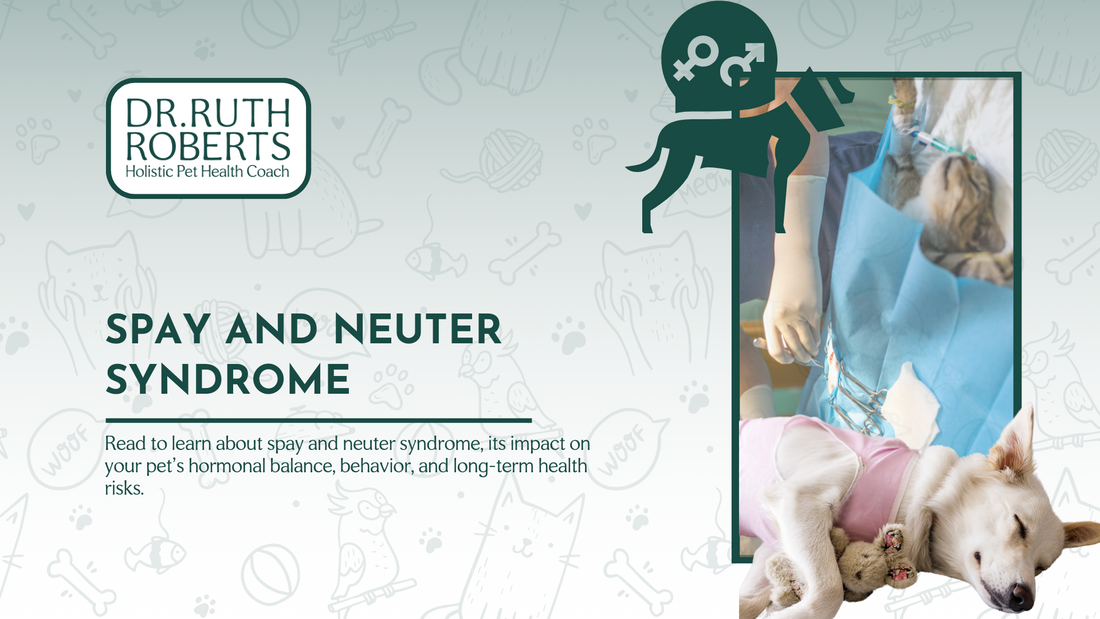Spay Neuter Syndrome, a term coined by Dr. Ruth Roberts, is a concept that suggests potential long-term health implications associated with early spaying or neutering of pets. This theory is rooted in the understanding that removing the reproductive organs during a pet's formative stages could potentially upset the delicate equilibrium of hormones that govern various bodily functions.
The idea behind Spay Neuter Syndrome stems from the recognition that the reproductive system is intricately intertwined with the broader physiological framework of an animal. Beyond its obvious role in reproduction, the reproductive system exerts a pervasive influence on other aspects of an animal's biology. Hormones produced by the reproductive organs orchestrate the developmental processes, impacting not only reproductive cycles but also behaviors, metabolic rates, and the development of various bodily systems.
How Does Spaying-Neutering Affect the Hormonal Balance in Pets?
Spaying and neutering have a significant impact on the hormonal balance in pets due to the removal of the reproductive organs (ovaries in females and testes in males) responsible for producing sex hormones. In females, spaying involves the removal of the ovaries, which are responsible for producing estrogen and progesterone. As a result, spayed females experience a sudden and significant decrease in estrogen and progesterone levels. The hormonal shift can influence behavior. Some spayed females may exhibit changes in temperament, energy levels, and social interactions. For example, they may become more shy, less territorial, show reduced maternal instincts, and exhibit altered patterns of play and socialization.

In males, neutering involves the removal of the testes, which are responsible for producing testosterone. When a male is neutered, the production of testosterone is significantly reduced or eliminated. This leads to a decrease in behaviors associated with mating, such as roaming in search of a mate and mounting other animals. Additionally, neutered males may experience a decrease in aggressive tendencies and territorial behaviors.
Is There a Correlation Between Spaying and Neutering and Cancer?
Spaying and neutering can potentially pose long-term risks of cancer due to their impact on hormonal balance and the removal of reproductive organs. In a recent study, highlight several research conducted over the past decade have examined the long-term health effects of neutering dogs. Specifically, the research indicates an elevated risk of various types of cancer in neutered dogs when compared to those that remain intact. Neutered dogs are more likely to develop osteosarcoma, a form of bone cancer. Additionally, spayed female dogs face increased risks of cardiac hemangiosarcoma, splenic hemangiosarcoma, lymphosarcoma, and cutaneous mast cell tumors compared to intact females.

Sex hormones, such as estrogen and progesterone in females and testosterone in males, play a role in regulating cell growth and differentiation. Changes in hormonal balance, which occur as a result of spaying and neutering, can potentially influence the development of certain types of cancer.
Reduced Risk of Reproductive-Related Cancers
Spaying and neutering can reduce the risk of certain reproductive-related cancers. For example, spaying a female dog before her first heat cycle significantly decreases the likelihood of mammary gland tumors. Neutering male dogs reduces the risk of testicular cancer.
Ongoing Research on Other Cancers
There is ongoing research and debate about potential associations between spaying or neutering and an increased risk of certain types of cancer. Some studies suggest potential links between early spaying/neutering and an elevated risk of cancers like osteosarcoma (bone cancer) and specific types of cancers in particular breeds.
Breed and Size Considerations
The risk of certain types of cancer may vary based on the breed and size of the pet. Some breeds are predisposed to specific types of cancer, and the decision to spay or neuter may need to be carefully considered in light of these breed-specific risks.
Potential for Weight Management
Spayed and neutered pets may be more prone to weight gain, which can be a risk factor for certain types of cancer. Obesity is associated with an increased risk of various health issues, including certain types of cancer.
Individual Health Considerations
Each pet is unique, and individual health factors play a significant role in cancer risk. Pet owners should discuss their pet's specific health history and breed predispositions with their veterinarian when making decisions about spaying or neutering.
How Does Spay/Neuter Can Potentially Pose Long-term Risks of Joint Disorders?
Spaying and neutering can potentially pose long-term health risks like joint disorders in pets due to their impact on hormonal balance and the timing of the procedure. Hormonal imbalance can influence the development of bones and joints, potentially leading to musculoskeletal issues. There has been a study focusing on joint disorders in neutered dogs. One study examined the effects of neutering on larger dog breeds and found a three-fold increase in the likelihood of developing a condition known as "excessive tibial plateau angle," which is associated with a higher risk of a specific type of knee ligament injury. Another study investigated this same knee ligament injury in various dog breeds and discovered that both neutered male and female dogs were two to three times more likely to experience this problem compared to dogs that hadn't been neutered.
Spaying and neutering involve the removal of reproductive organs responsible for producing sex hormones (estrogen and progesterone in females, testosterone in males). These hormones play a crucial role in regulating various physiological processes, including bone development.
Influence on Growth Plates
Growth plates are specialized areas of developing tissue found in the bones of young animals. They are responsible for bone lengthening and shape formation. Hormones, particularly sex hormones, play a vital role in the regulation of growth plate closure. Removal of these hormones through spaying or neutering can potentially disrupt this process.
Potential for Early Closure
If a pet is spayed or neutered at a young age, before reaching full maturity, there is a possibility that growth plates may close prematurely. This can result in abnormalities in bone length and shape, potentially leading to joint disorders.
Increased Risk in Large and Giant Breeds
Large and giant breed dogs are particularly susceptible to joint disorders like hip dysplasia and cruciate ligament tears. Studies have suggested that early spaying or neutering in these breeds may be associated with a higher risk of these conditions. The potential link between hormonal alterations and joint health is an area of ongoing research.
Orthopedic Issues
Joint disorders such as hip dysplasia involve abnormal development of the hip joint, leading to instability and potentially painful arthritis. Cruciate ligament tears affect stability in the knee joint. These conditions can cause pain, lameness, and reduced mobility.
Considerations for Breed and Size
The risk of joint disorders may vary based on the breed and size of the pet. Larger and heavier breeds are generally more prone to orthopedic issues, and early spaying or neutering in these cases may warrant careful consideration.
How Does Spay/Neuter Can Potentially Pose Long-term Risks of UTI?
Spaying and neutering can potentially lead to an increased risk of Urinary Tract Infections (UTIs). Spaying and neutering involve the removal of the reproductive organs responsible for producing sex hormones (estrogen and progesterone in females, testosterone in males). These hormones play a role in regulating various bodily functions, including the health of the urinary tract.

Impact on the Urinary Tract in Females
In female pets, spaying involves the removal of the ovaries, which are the primary source of estrogen and progesterone. These hormones play a role in maintaining the health and function of the urinary tract. When these hormones are removed, it can potentially lead to changes in the urinary tract's environment, making it more susceptible to infections.
Increased Risk of Incontinence
Spayed females, especially those spayed before their first heat cycle, may face a higher risk of developing urinary incontinence. This condition arises due to a weakening of the muscles that control the bladder, leading to difficulties in controlling urination. Incontinence can create an environment that is more conducive to the development of UTIs.
Anatomical Considerations
The anatomy of the urinary tract can be influenced by spaying and neutering. In females, the removal of the ovaries can lead to changes in the structure and function of the urinary sphincter, potentially affecting the ability to fully empty the bladder. In males, neutering may also have subtle anatomical effects on the urinary tract.
Potential for Bacterial Overgrowth
Changes in hormonal balance and urinary tract anatomy can potentially create an environment where bacteria have a greater opportunity to thrive. This can lead to an increased risk of bacterial colonization and UTI development.
How You Can Help Your Pet Reduce Post-spay/neuter Health Risks?

While Spay Neuter Syndrome sparks important discussions in the field of veterinary medicine, it's crucial to note that the concept is not without its own debates and ongoing research. It's also important to recognize that not all pets will experience risks and complications after being spayed or neutered. As responsible pet owners, it is imperative to observe your pet's behavior and overall health for any unexpected changes following the procedure. You can take this quiz to determine if your pet might exhibit symptoms related to Spay Neuter Syndrome. Additionally, here are steps you can take to support your pet and mitigate the risk of Spay Neuter Syndrome:
- Balanced Diet: Ensure your pet has a diet suitable for their age and size. Control portions to avoid weight gain.
- Anti-inflammatory Supplements: Add anti-inflammatory supplements like 'Heal Hemp Oil' and turmeric to your pet's diet for inflammation control.
- Regular Exercise: Keep your pet active with regular exercise to support their weight, muscle tone, and overall health.
- Monitor Weight and Body Condition: Watch your pet's weight and consult a vet for any significant changes.
- Consult with a Vet or a Certified Holistic Pet Health Coach, schedule regular check-ups with for tailored advice.
- Consider Age and Breed Factors: Account for your pet's breed and age in their diet and exercise.
- Provide Mental Stimulation: Use puzzle toys and training to keep your pet mentally stimulated.
- Avoid Rapid Growth in Puppies: Control growth in puppies to prevent musculoskeletal issues by managing diet and exercise.
- Address Behavioral Changes: Seek vet advice for any significant changes in behavior post-surgery
- Maintain Dental Health: Maintain your pet's dental health with regular brushing and professional cleanings.
- Stay Informed: Keep up-to-date with the latest research and recommendations regarding spaying and neutering practices, especially in relation to specific breeds or sizes. This will help you make informed decisions about your pet's health care.
Conclusion
In conclusion, the concept of Spay Neuter Syndrome, coined by Dr. Ruth Roberts, highlights the potential long-term health implications associated with early spaying or neutering of pets. This theory revolves around the idea that removing reproductive organs during a pet's formative stages can disrupt the delicate hormonal balance that governs various bodily functions.
The reproductive system is intricately linked to an animal's overall physiology, influencing not only reproductive cycles but also behaviors, metabolic rates, and the development of various bodily systems. Spaying and neutering can have a significant impact on hormonal balance, resulting in changes in behavior and potential health risks.
Estrogen and progesterone in females, as well as testosterone in males, are pivotal hormones that regulate not only reproductive functions but also various aspects of metabolism, bone health, and behavior. Disrupting this hormonal balance through spaying or neutering can lead to health concerns, including an increased risk of certain cancers, joint disorders, and urinary tract infections.
While it's essential to acknowledge the ongoing debates and research in the field of Spay Neuter Syndrome, responsible pet owners can take proactive steps to support their pets and mitigate potential risks. Providing a balanced diet, incorporating anti-inflammatory supplements, ensuring regular exercise, monitoring weight and body condition, consulting with a veterinarian or certified holistic pet health coach, and considering age and breed factors are all essential aspects of responsible pet care.

















